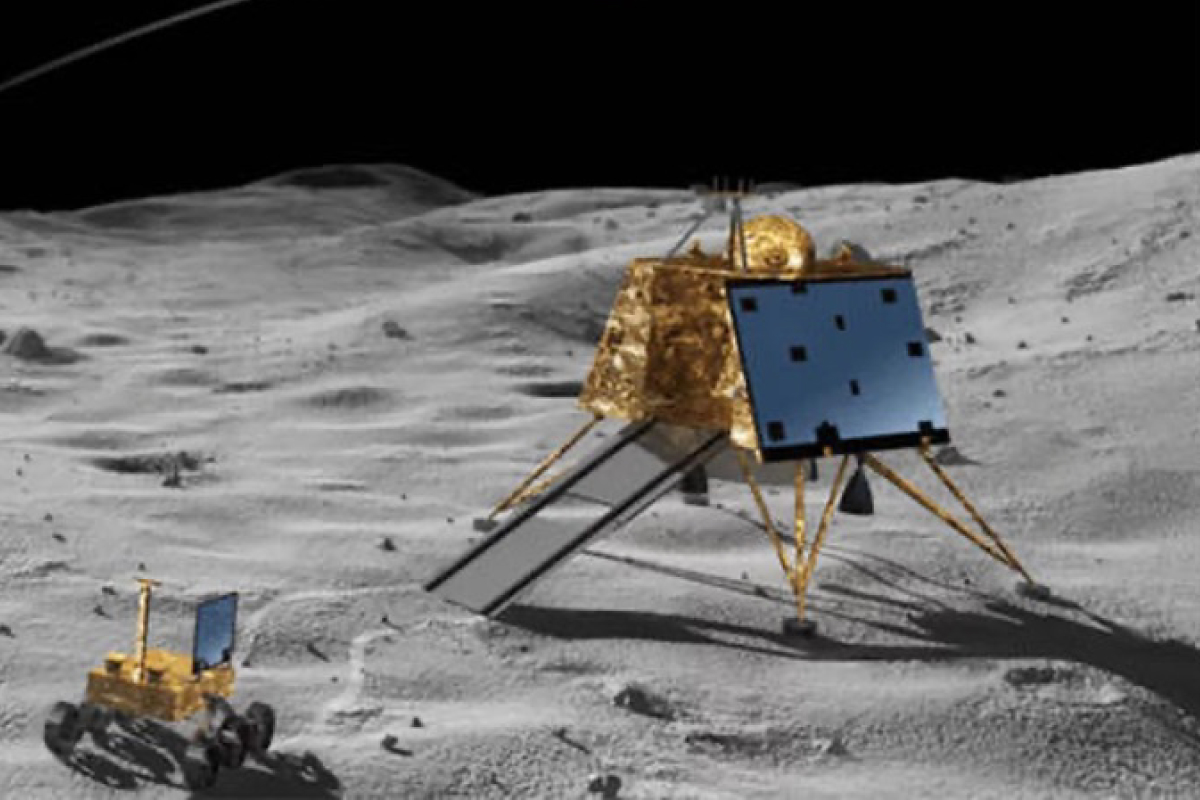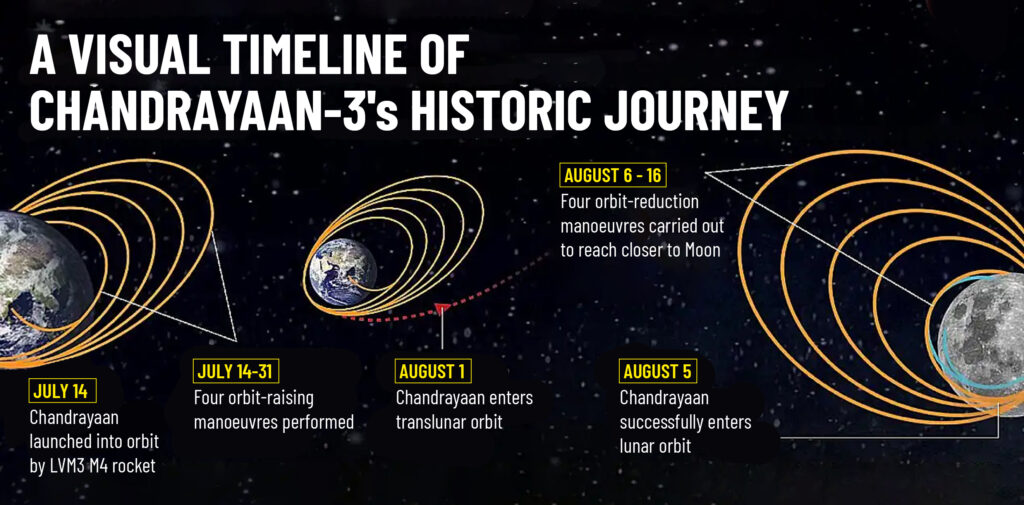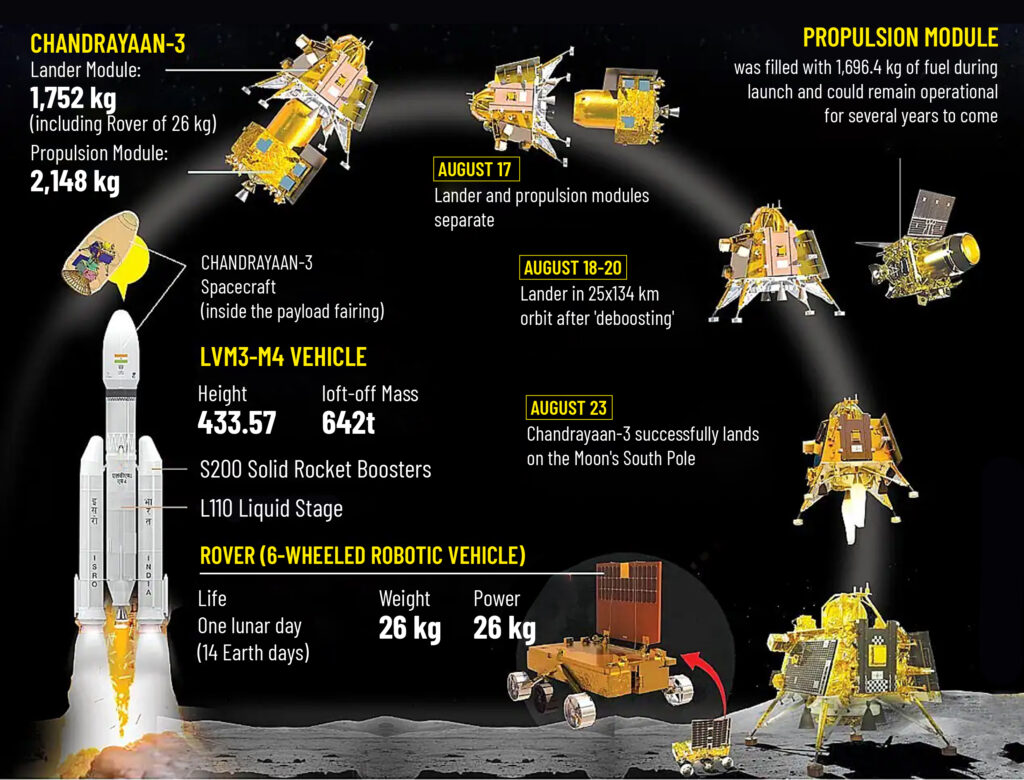Published
1 year agoon

India’s space program has reached new heights with the successful landing of the Chandrayaan-3 robotic lander near the moon’s South Pole. This remarkable achievement has elevated India to the status of a “space superpower,” making it the fourth nation, after the United States, China, and the former Soviet Union, to land an operational spacecraft on the moon. The Chandrayaan-3 mission, managed by the Indian Space Research Organisation (ISRO), aims to demonstrate soft-landing and rover technology as crucial steps towards future deep space exploration.


On July 14, 2023, at 5:05 a.m. EDT, the Chandrayaan-3 mission embarked on its journey to the moon from the Satish Dhawan Space Center in Sriharikota, India. Aboard the medium-lift Launch Vehicle Mark-III (LVM3) rocket, the spacecraft set off for the lunar surface, carrying the Vikram lander and the Pragyan rover.
After a successful journey, the Chandrayaan-3 spacecraft landed near the moon’s South Pole on August 23, 2023, marking a red-letter day for Indian space travel. The landing was a moment of great celebration for the Indian Space Research Organisation, with engineers, mission managers, dignitaries, and guests erupting in cheers and applause.
The Chandrayaan-3 mission has three primary objectives. The first is to achieve a safe landing on the lunar surface, showcasing India’s expertise in soft-landing technology. The second objective is to demonstrate the operations of the rover, named Pragyan, which will explore the moon’s surface and perform scientific experiments. Lastly, Chandrayaan-3 aims to conduct various scientific investigations, including measuring temperature and thermal conductivity, detecting lunar seismic activity, and studying the plasma environment.
The Chandrayaan-3 lander, named Vikram, is a box-shaped spacecraft equipped with four landing legs and four landing thrusters. It carries several instruments, including the Chandra’s Surface Thermophysical Experiment (ChaSTE) to measure temperature and thermal conductivity, the Instrument for Lunar Seismic Activity (ILSA) to detect moonquakes, and the Langmuir Probe to estimate plasma density in the moon’s environment. Additionally, the lander carries a Laser Retroreflector Array provided by NASA, which aids in measuring the moon’s distance from Earth.
The Pragyan rover, mounted on a six-wheel rocker-bogie wheel drive assembly, is designed to explore the lunar surface. It communicates with Earth through the lander and carries instruments such as the Alpha Particle X-ray Spectrometer (APXS) to analyze the elemental composition of lunar soil and rocks, and the Laser Induced Breakdown Spectroscope (LIBS) to examine the chemical composition of the surface.
The Chandrayaan-3 mission deploys various scientific payloads across the lander, rover, and propulsion module. The lander’s payloads include instruments like ChaSTE, ILSA, Langmuir Probe, and the NASA-provided Laser Retroreflector Array. The rover’s instruments, APXS and LIBS, enable the analysis of lunar soil and rocks. The propulsion module, in addition to its crucial role in transporting the lander and rover, carries out the Spectro-polarimetry of Habitable Planet Earth (SHAPE) investigation, aiding in the search for exoplanets with similar characteristics to Earth.
The Chandrayaan-3 mission builds upon the valuable lessons learned from its predecessor, Chandrayaan-2. The Chandrayaan-2 mission faced challenges during its landing attempt, but the Chandrayaan-3 team has optimized the mission design to address these issues.
One notable improvement is the addition of two hazard detection and avoidance cameras on the lander, enhancing its ability to navigate and avoid obstacles during descent. Furthermore, Chandrayaan-3 simplifies the mission by excluding an orbiter, allowing the propulsion module of Chandrayaan-2 to handle all communications with Earth.
India’s exploration of the moon holds tremendous significance for global space exploration. The detection of water ice on the moon’s surface during the Chandrayaan-1 mission was a significant finding, contributing to our understanding of the moon’s resources. With Chandrayaan-3’s landing near the moon’s South Pole, an area of interest due to potential ice deposits, India continues to play a crucial role in unravelling the mysteries of the moon. The data gathered by Chandrayaan-3 will not only benefit future Indian missions but also contribute to international efforts, such as NASA’s Artemis program, which aims to send astronauts to the moon’s South Pole.
Chandrayaan-3’s successful landing marks a significant milestone in India’s space program. With plans for future missions to deep space targets and the signing of the Artemis Accords, India’s commitment to space exploration is evident. Collaborations between nations, including the United States, China, Japan, and private companies, further emphasize the growing interest in lunar exploration. The moon’s South Pole, with its potential resources and scientific value, has become a focal point for future missions that aim to pave the way for human colonization and deep space exploration.
Global perspectives
The accolades were swift to come in, with the BBC hailing this watershed event, saying this is “a massive moment for India – and it bumps them up the space superpower list.” The Guardian was quick to join in, saying “The successful landing marks India’s emergence as a space power”. The New York Times chimed in, saying the program “adds to the achievements of the country’s homegrown space program” and that “the achievement of Chandrayaan-3 may be even sweeter, as it comes at a particularly important moment in the South Asian giant’s diplomatic push as an ambitious power on the rise.”
India’s Chandrayaan-3 mission has propelled the country’s space program to new heights, solidifying its position as a space superpower. The successful landing near the moon’s South Pole showcases India’s technological prowess and sets the stage for future ambitious missions.
With the Chandrayaan-3 lander and rover conducting scientific experiments and collecting valuable data, the mission significantly contributes to our understanding of the moon’s resources and paves the way for future human exploration. India’s achievements in space exploration serve as a testament to the country’s dedication to scientific progress and international collaboration in the pursuit of knowledge beyond our planet, and will doubtlessly raise the stature of India as a global superpower of eminence, be it when it comes to space travel or beyond.


Innodata: Championing Gender Diversity, Inclusion, and Equal Opportunity


How do you ensure that your leadership team embodies and models the desired behaviors and culture you want to cultivate?


Avani Lekhara wins gold medal at Paralympics with record-breaking score


Fostering a Culture of Continuous Learning and Development at Drychem


The Lifelong Advantage: Embracing Continuous Learning and Professional Development


Cyble: Setting the Benchmark as a Most Preferred Workplace Through Innovation, Well-being, and Employee-Centric Design

